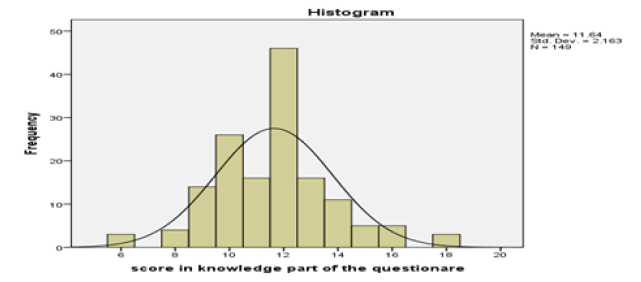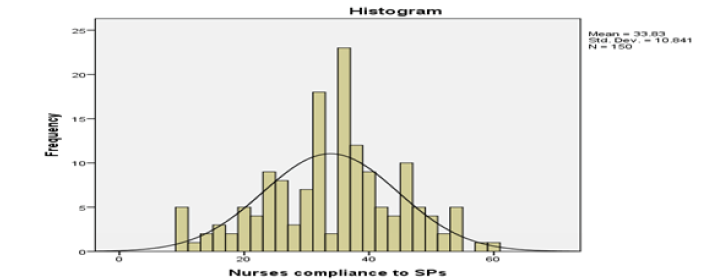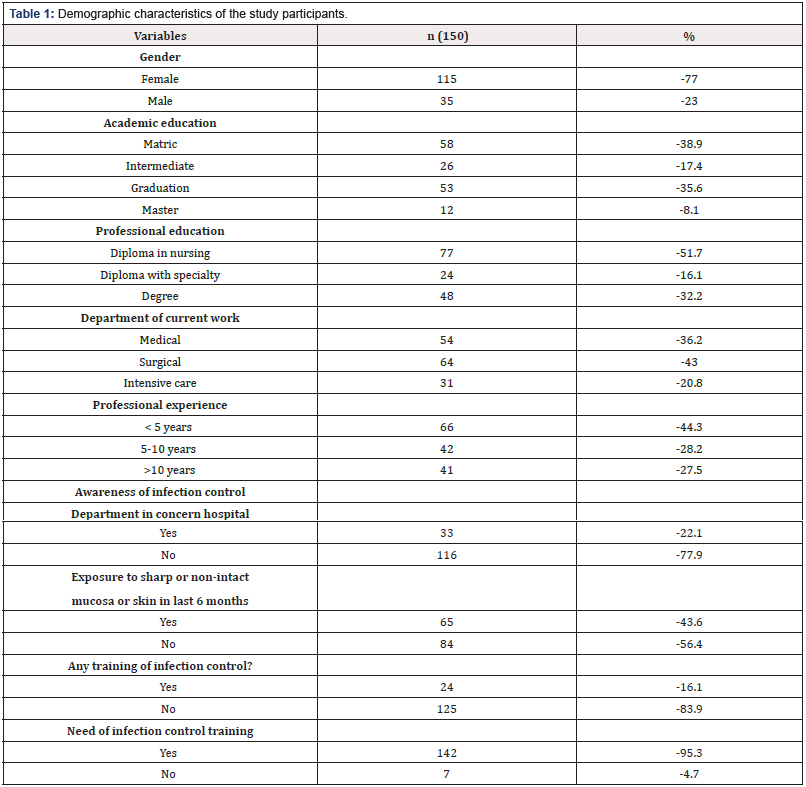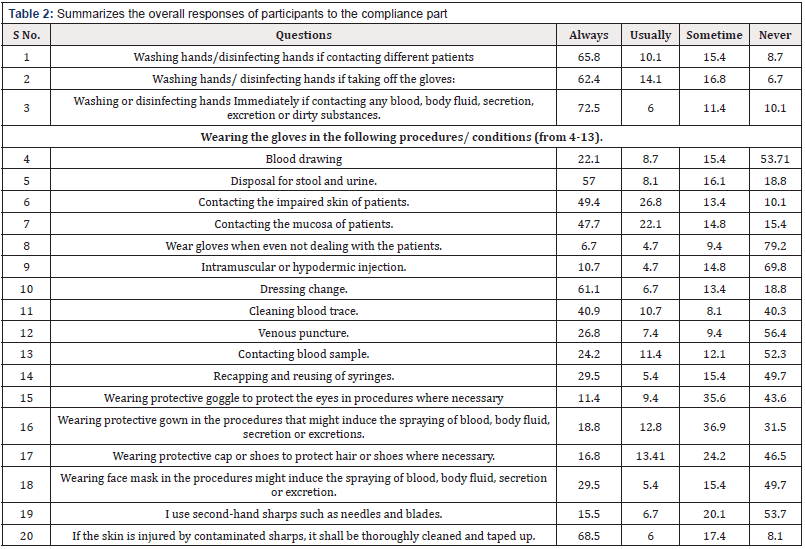Research Article 
 Creative Commons, CC-BY
Creative Commons, CC-BY
Factors Affecting Nurses’ Compliance to Standard Precautions in Resource Scarce Settings
*Corresponding author: Aurang Zeb, Rehman College of Nursing Peshawar, Pakistan.
Received: August 05, 2019; Published: August 22, 2019
DOI: 10.34297/AJBSR.2019.04.000840
Abstract
Background: Standard precautions are universally accepted guidelines for infection control practices in health care settings. Good compliance to standard precautions prevents nurses from occupational exposure to blood and body fluid and decrease the risk of infection transmission to them as well as to patients.
Aim: The overarching aim of the study was to determine nurses’ knowledge, their compliance and factors affecting their compliance to SPs in resource scarce settings.
Method: A cross sectional study was conducted to determine nurses’ knowledge, compliance and factors affecting their compliance to SPs in three tertiary care public sector hospitals in Peshawar. A total of 199 registered nurses were recruited to the study through Stratified random sampling. SPSS version 20 was used for data analysis.
Results: The mean knowledge score reported was 11.64(58.2%) with SD of 2.16(10.8%) out of 20(100%) marks. The maximum score documented was 18(90%) whereas the minimum score was 6(30%). A significant result with p-value 0.011 was obtained between training of infection control and SPs Knowledge. The mean compliance score was 33.83(56.38%) with SD of 10.84 (18.06%), with the maximum value 59(98.33%) and the minimum value of 10(16.67%) out of 60(100%). A significant association was noted between gender and compliance (p-value 0.006) and as well as between infection control training and compliance (p-value 0.001). Contributing factors towards noncompliance to SPs reported were lack of resources, workload and lack of infection control policies.
Conclusion: This study identifies that nurses working in tertiary care hospitals of Peshawar do not have enough knowledge and compliance to SPs. The study suggests that health authorities should take necessary actions for developing and implementing infection control practices in these hospitals.
Introduction
Standard precautions are universally accepted guidelines for infection control practices in health care settings regardless of the infection status of a patient [1]. These guidelines not only help in preventing health care workers from getting infection while caring for a patient but also reduce the spread of infection among patients. Universal precautions are based on the premise that every patient is potentially infectious [2]. However, the focus was to prevent Health Care Workers (HCWs) from exposure to blood borne pathogens. With the passage of time, these preventive guidelines were modified not only to prevent exposure to blood but also to body fluids, and this modified version of universal precautions were given the name of standard precautions (SPs) in 1996 by CDC [3].The infectious status of a patient is not always confirmed so it is recommended that standard precautions should be applied while dealing with all types of patients regardless of the infectious status of a patient. Standard precautions assume that the blood and all sorts of body fluids including secretions and excretions may have the potential to transmit pathogens even though when the patient does not have confirmed presence of infectious agent [4].
Studies report that nurses in different parts of the world have insufficient knowledge of SPs and infection control practices. Lack of their knowledge to HAIs make them prone to different infections. 56% of HCWs of a large teaching hospital in Chicago had good knowledge of SP [5]. Study by [6] in New York to identify the Nurses knowledge and their compliance to standard precaution reported that that the mean score of nurses to standard precaution knowledge was 81+17 % of the nurses have good compliance to SPs [6]. Similarly, a study on 4439 healthcare workers including nurses to determine their knowledge to Standard precaution by ML Atif et al. [7] in 34 healthcare institute of France reported that the mean score on hand hygiene part of the questionnaire was 72.6% while only 7.35% correct answers were given by the respondent to the use of appropriate barriers and disposal [7]. 90.0% of the nurses felt the need for a formal training on SPs and infection control working in a university affiliated hospital in Iran [8]. Student nurses studying in different hospitals of Hong Kong China, have 78.2% knowledge of SPs [9]. A study conducted on 594 nursing students of six public sector and four private hospitals in Jordin showed that 79% of the students answered correctly the part of questionnaire related to Knowledge about standard precaution [10].
Nurses from different parts of the world have varying level of compliance to SPs. Report of the French audit general on compliance to standard precautions concluded that HCWs have good compliance up to 94% to hand hygiene [11]. A comparative study on nurses of Brazil and Hong Kong showed that compliance to standard precaution among nurses working in Brazil was 69.4% as compared to those working in Hong Kong was 57% [12]. Wilson 2006 reported that 37% of Nurses have poor compliance to standard precautions [13]. Study conducted in six NHS trusts in Wales during 2006 and 2008 reported that 47% of the respondents including surgeons and scrub nurses never wore protective devices, whereas 10.8% never used protective googles, 5.6% also responded that they never avoided passing of sharp object from hand to hand [14].
A study conducted in China by Luo, Y on nurses’ compliance to SPs found that 64% of nurses have good compliance to standard precautions. Study on student’s compliance to SPs in six public and four private universities in Joran resulted in mean compliance score was 67.4% [10]. Whereas students in Mazdaran hospital depicted different findings; the study reported that that 6% to 37% of health care workers and 47% medical students don’t know about standard precautions [15]. Students nurses in different hospitals of Hong Kong China shows that the overall compliance frequency was 4.38+0.40 out of 5 [16]. Mean compliance of students’ nurses in Jordin was 67 out of 80 marks [16,17]. Whereas 57% of the HCWs including doctors and Nurses has good compliance to SP in Zagazig university hospital Egypt [18].
In Cyprus unavailability of equipment, negative influence of equipment on nurses, workload, psychological factors, working experience as a nurse and physician influence are the main factors affecting their compliance? Chan MF [19] reported that educational level (p value .001), work experience (p value .001), and training per hour (p value .001) in a year were the significant factors affecting nurse’s compliance to SPs [19]. In a dental School Iran, lack of knowledge, workload, lack of facilities and interpersonal conflicts are the key factors reducing compliance to standard precautions. Lack of health care workers’ knowledge related standard precaution is a main factor affecting the health care workers compliance to standard precautions in Zagazig university hospital Egypt [18]. Factors that enhance the nursing students’ compliance to standard precaution knowledge in Hong Kong were good infection control training, effective managerial support, perceived susceptibility and perceived benefits of compliance [20]. Lack of knowledge, lack of means and lack of time are the factors that influence the health care worker compliance to standard precautions [21]. Study conducted in Civil hospital Karachi Pakistan on the physician compliance to standard precaution shows that unavailability of resources 58% are the main factor of non-compliance to standard precautions, while 20% of the participant on this study responded that it is not practical [10]. Though there are few studies available on the topic in different part of the world but there is a dearth of studies on this topic from Pakistani context.
Method
Quantitative cross-sectional analytical study design was used for the study. The study population was registered nurses working in the medical and surgical wards and ICUs of the three major tertiary care hospitals of Peshawar including Leady reading hospital, Khyber teaching hospital and Hayatabad medical complex Peshawar. A major pool of nurses is working in these hospitals, so the study might help in depicting a clear picture of nurses’ compliance to SPs and factors affecting it in the province. Stratified random sampling technique was applied for the selection of sample, for making the strata these hospitals were stratified in to medical, surgical wards and intensive care units and then participants were selected randomly from each of these stratums. Sample size was calculated on CDC Epi-info software. The total population was 361, Margin of error is kept 5% and a nonresponse rate of 20%, the calculated sample size was 199. The inclusion criteria for the study was qualified nurses registered with Pakistan Nursing council who have experience more than one year and are directly related to patients care.
Ethics approval was obtained from ethics review board of university. A well explained informed consent was presented to the participants before data collection to ensure their safety and confidentiality. The data was collected from the participants through structured questionnaire. Questionnaire was adopted form Askarian et al. [8] and amended according to the nature of the study. The validity of the questionnaire is 0.98, reliability is 0.87.
The data was analyzed using SPSS version 22.0. In descriptive statistics frequencies and percentages were used for categorical and nominal variables. Means and standard deviation were calculated for continuous data. In inferential statistics independent sample t-test and ANNOVA with post hoc Tukey test were applied to continuous data while chi square on categorical variables.
Results

Chart 1: A significant result with p-value 0.011 was obtained when independent T test was applied on training of infection control and SPs Knowledge.
The demographic characteristic of participants is summarized in Table 1. The mean knowledge of participants related to SPs is 11.64+2.16 out of 20 with maximum 18 and minimum 6 30%. Chart 1 shows the result. A significant result with p-value 0.011 was obtained when independent T test was applied on training of infection control and SPs Knowledge. The mean compliance is 33.83+10.84 with the maximum 59 while the minimum 10 out of 60. Chart 2 shows the result. Applying independent sample T-test a highly significant association were noted between gender with compliance and between infection control training status and compliance with p-values of 0.006 and 0.001 respectively. Table 2 summarizes the overall responses of participants to the compliance part. 10 questions were asked about factors affecting Nurses compliance to SPs. Unavailability of resources like personal protective equipment (PPEs) were highlighted by 73.6% participants as factors affecting nurses’ compliance. 55.7% participants highlighted workload while 75.8% participants mentioned that unavailability and dissemination of infection control policies as main factor affecting their compliance to SPs. The overall result of factors affecting nurses’ compliance to SPs is given in Table 3.
Discussion
Nurses’ knowledge regarding SPs and compliance is crucial for any improvement in the health services. A limited published literature is available on patient satisfaction with nursing care in Pakistan, a study conducted in a district Headquarter hospital of DI Khan showed that 45% of patient were satisfied from nursing care [22]. As for as infection control measure is concerned an interventional study conducted at Aga Khan University hospital from January 2002 to December 2007 reported 1382 needle stick injuries with highest incidence among junior doctors 28.5% followed by 20.4% incidence among Nurses [23]. The knowledge of nurses working in tertiary care hospitals of Peshawar regarding standard precautions as per findings of current study is 11.64 (58.2%) +2.16 (10.8%) out of 20 (100%) marks. The findings of this study are consistent with a study conducted in a large teaching hospital of Chicago where 56% of HCWs have good knowledge of SPs [17]. However, these findings are contrary to the findings of study by Power D [6] conducted in New York where the mean knowledge was 81%. Study in a large teaching hospital in Geneva Switzerland shows that 55.9% participants given correct answers to 10 or more of the 13-item questionnaires [21]. 95.3% nurses in current study feel that they need formal training on infection control and SPs as compared to study in a university affiliated hospital Shiraz Iran showed that 90.0% of the nurses need a formal training on SPs and infection control [20].
A study in acute care hospital in Hong Kong shows 7.28 Knowledge score out of 11(39).79% of nursing students in six public sector and four private hospitals in Jordin correctly answered the part of questionnaire related to SPs’ Knowledge [24]. The mean knowledge score of nursing students of a university hospital Jordan was 49.6% [25]. A study conducted in Civil Hospital Karachi by Jawad M 2009 shows that 52% of the doctors working in civil hospital Karachi don’t know about CDC standard Precautions [11]. As for as the nurse’s compliance to SPs is concern, the mean score related to nurse’s compliance to standard precaution is 33.83¬+10.84. Nurses from different part of the world have different level of compliance to SPs. Report of the French audit general on compliance to SPs shows that HCWs have good compliance up to 94% to hand hygiene [12]. Descriptive correlational study conducted by Power D [6] in New York results that 17.4% nurse’s responded positive compliance on all the 9 items of the questioner [6]. To compare nurses’ compliance to SPs between nurses of Brazil and honking by Pereira [9], shows that the mean compliance of Nurses working in Brazil was 69.4% as compare to those from Hong Kong was 57% [13]. Study in six NHS trusts in Wales during 2006 and 2008 results that 47% of the respondents including surgeon and scrub nurses never wear protective devices whereas 10.8% never wear protective goggles [25].
In current study 10.1% nurses never wash hands when going from one patient to other, while 10.1% never use gloves, 15.5% of the participants never use secondhand sharps and 29.5% never recap syringes. As per French national audit report 34.5% nurses are not wearing gloves while performing a hypodermic injection and 24.4% are not complained to wearing protective eye googles where necessary, as compare to this study where 69.8% of nurses don’t wear glove for hypodermic injection and 43.6% don’t wear protective googles where necessary [12]. Study conducted in China by Luo Y [24] shows that 64% of nurses in china have good compliance to standard precautions [24]. AL Rawajfah OM [10] in 2012 conducted study in six public and four private universities in Jordan results the mean compliance score of 67.4% [10]. The overall compliance of student’s nurses in Hong Kong was 4.38+0.40 out of 5 [9], whereas student nurses in Jordin scored 67 out of 80 marks regarding compliance to SPs [10]. 57% of the HCWs has good compliance to SP in Zagazig university hospital Egypt [18]. In Pakistani context a study conducted in Civil Hospital Karachi shows that 60% of health care workers knows about the CDC guidelines of standard precaution, while 45% of the HCWs are not complained to standard Precautions [11].
Factors affecting Nurses compliance to SPs highlighted by participants in current study include, unavailability of resources like personal protective equipment (PPEs) by 73.6%, 55.7% Participants highlighted workload due to shortage of staff 75.8% elaborated unavailability and dissemination of infection control policies. Study conducted by Efstathiou G [17] shows that workload, unavailability of equipment and patient’s discomfort are the factors affecting Nurses compliance to SPs [17]. Lack of facilities provision and maintenance, heavy workload and lack of good role models were factors determined by Hedayati H [20] in a dental School Iran [20]. Susceptibility to HCV and barriers to SPs were factors highlighted by Power D [6]. Unavailability of protective modalities were factors affecting HCWs’ compliance to SPs in Civil hospital Karachi [11].
Conclusion
This study makes contribution to the vast body of knowledge on infection control practices among nursing staff from Pakistani context. The study findings may have implications for other developing countries. The study validates the findings of previously conducted studies in Chicago, Switzerland and Iran. Additionally, the study identifies factors affecting nurses’ compliance to SPs that include increased workload, lack of equipment and unavailability of infection control policies. The study found a significant association between infection control training and knowledge of SPs. Likewise, a significant relation was also noted between professional education, gender and status of infection control training with compliance. The study recommends that to control nosocomial infections in public sector hospitals in Pakistan infection control policies need to be developed and implemented.
References
- Kermode M, Jolley D, Langkham B, Thomas MS, Holmes W, et al. (2005) Compliance with Universal/ Standard Precautions among health care workers in rural north India. Am J Infect Control 33(1): 27-33.
- Twitchell KT (2003) Bloodborne pathogens. What you need to know-- Part II. AAOHN J 51(2): 89-97.
- Siegel Rhinehart JD, Jackson E, Chiarello ML (2007) The Healthcare Infection Control Practices Advisory Committee: Guideline for Isolation Precautions: Preventing Transmission of Infectious Agents in Healthcare Settings. pp. 1-206.
- Siegel JD, Rhinehart E, Jackson M, Chiarello L (2007) Guidelines for isolation precautions: preventing transmission of infectious agents in health care settings. Am J Infect Control 35(10): S65-164.
- Sax H, Perneger T, Hugonnet S, Herrault P, Chraïti MN, et al. (2005) Knowledge of standard and isolation precautions in a large teaching hospital. Infect Control Hosp Epidemiol 26(03): 298-304.
- Powers D, Armellino D, Dolansky M, Fitzpatrick J (2016) Factors influencing nurse compliance with Standard Precautions. Am J Infect Control 44(1): 4-7.
- Atif ML, Brenet A, Hageaux S, Fave MH, Cochet C, et al. (2013) Awareness of standard precautions for 4439 healthcare professionals in 34 institutions in France. Med Mal Infect 43(1): 10-16.
- Askarian M, Memish ZA, Khan A (2007) A Knowledge, practice, and attitude among Iranian nurses, midwives, students regarding standard isolation precautions. Infect Control Hosp Epidemiol 28(2): 241-244.
- Pereira FM, Lam SC, Chan JH, Malaguti Toffano SE, Gir E (2015) Difference in compliance with Standard Precautions by nursing staff in Brazil versus Hong Kong. Am J Infect Control 43(7): 769-772.
- AL Rawajfah OM, Tubaishat (2015) A Nursing students’ knowledge and practices of standard precautions: A Jordanian web-based survey. Nurse Educ Today 35(12): 1175-1180.
- Jawaid M, Iqbal M, Shahbaz S (2009) Compliance with standard precautions: A long way ahead. Iranian Journal of Public Health 38(1): 85-88.
- Giard M, Laprugne Garcia E, Caillat Vallet E, Russell I, Verjat Trannoy D, et al. (2016) A Compliance with standard precautions: Results of a French national audit. Am J Infect Control 44(1): 8-13.
- Sadoh WE, Fawole AO, Sadoh AE, Oladimeji AO, Sotiloye OS (2006) Practice of universal precautions among healthcare workers. J Natl Med Assoc 98(5): 722-726.
- Cutter J, Jordan S (2012) Inter-professional differences in compliance with standard precautions in operating theatres: a multi-site, mixed methods study. Int J Nurs Stud 49(8): 953-968.
- Motamed N, Baba Mahmoodi F, Khalilian A, Peykanheirati M, Nozari M (2006) Knowledge and practices of health care workers and medical students towards universal precautions in hospitals in Mazandaran Province. East Mediterr Health J 12(5): 661-669.
- Cheung K, Chan CK, Chang MY, Chu PH, Fung WF, et al. (2015) Predictors for compliance of standard precautions among nursing students. Am J Infect Control 43(7): 729-734.
- Efstathiou G, Papastavrou E, Raftopoulos V, Merkouris A (2011) Factors influencing nurses’ compliance with Standard Precautions in order to avoid occupational exposure to microorganisms: A focus group study. BMC Nurs 10(1): 1.
- Orabi Ee (2017) Standard Isolation Precautions Educational Intervention on Undergraduate Medical Students of Zagazig University. Zagazig University Medical Journal 23(4): 1-14.
- Chan MF (2010) Factors affecting the compliance of operating room nursing staff toward standard and transmission-based precautions in an acute care hospital. Am J Infect Control 38(8): 666-667.
- Hedayati H, Marjadi B, Askarian M (2014) Barriers to standard precautions adherence in a dental school in Iran: A qualitative study. Am J Infect Control 42(7): 750-704.
- Khan MH, Hassan R, Anwar S, Babar TS, Babar KS, et al. (2007) Patient satisfaction with nursing care. Rawal Medical Journal 32(1): 28-30.
- Zafar A, Habib F, Hadwani R, Ejaz M, Khowaja K, et al. (2009) Impact of infection control activities on the rate of needle stick injuries at a tertiary care hospital of Pakistan over a period of six years: an observational study. BMC Infect Dis 9(1): 78.
- Luo Y, He GP, Zhou JW (2010) Factors impacting compliance with standard precautions in nursing, China. Int J Infect Dis 14(12): e1106-e1114.
- Levin KA (2006) Study design III: Cross-sectional studies. Evid Based Dent 7(1): 24-25.
- Darawad MW, Al Hussami M (2013) Jordanian nursing students’ knowledge of, attitude towards, and compliance with infection control precautions. Nurse Educ Today 33(6): 580-583.







 We use cookies to ensure you get the best experience on our website.
We use cookies to ensure you get the best experience on our website.